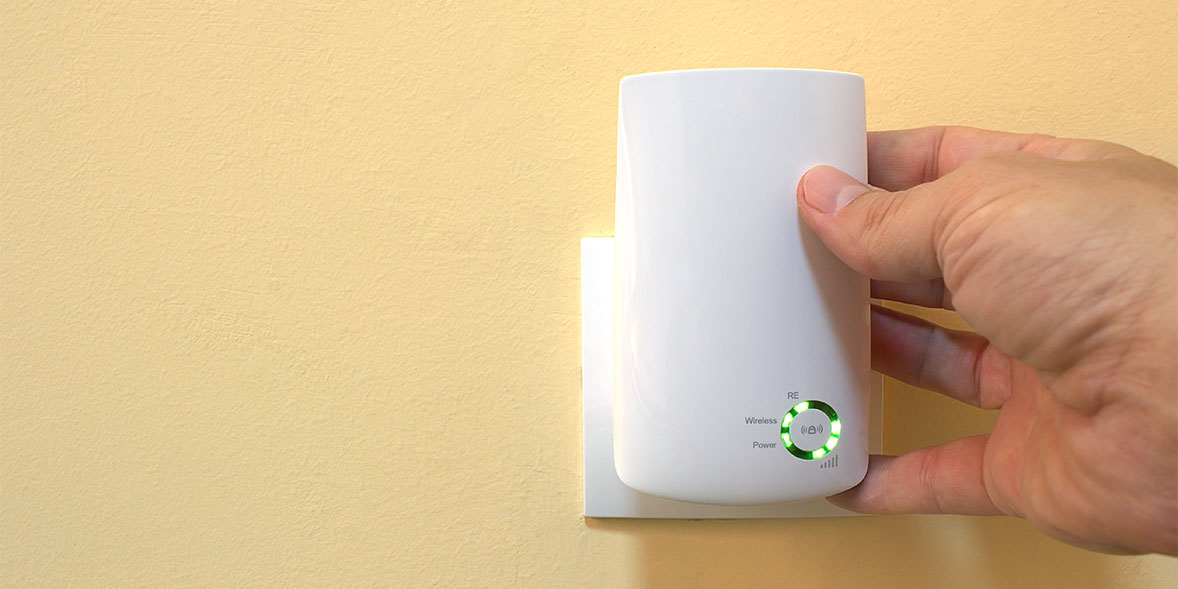6 ways to improve wi-fi in the garden or outdoors

If you're working on your laptop in the sunshine, streaming media for a gathering in your garden, making a video call outside or anything else that's a bit too far from your router, your wi-fi might not be up to the task.
Many will find weak signals ruin the enjoyment of taking devices outside, which could mean you end up relying on mobile data or just giving up and going back inside.
However, there are fixes that'll allow you to keep your whole property networked from corner to corner. Read on for six ways to boost your signal, including an option that costs nothing at all.
Get ready for bank holidays by finding the best barbecues, pizza ovens and prosecco for a summer bash.
1. Change your router band and channel – free fix to try first

- Pros It's a free way to improve your connection, a good solution if you live in a busy area with lots of people around, and you can do it immediately.
- Cons If your networking problems are caused by insufficient hardware or slow service from your provider then it won't help much, it can be difficult if you aren't used to changing your router settings, and you could make the problem worse if you pick a busier channel, some devices only work with the 2.4GHz band.
This advice is useful for more than just using your wi-fi outside: it's an evergreen tip to boost your speed and enhance performance. To avoid signals getting congested, they use different channels. 2.4GHz routers can use 11 channels, 5GHz routers can use 45 and 6GHz can use 59.
The first thing you should try if you're getting poor wi-fi speeds is changing the wi-fi channel. You can do this in the settings page – open a web browser and type your router's IP address into the address bar. You should be able to find this written on the back of your router. However, an easier option is simply to turn the router off, wait a couple of minutes, and turn it back on again. It should choose a less crowded channel.
If that doesn't work, inside that settings page you'll also be able to change your router band. You should be able to choose between the 2.4GHz and 5GHz frequencies, and in some rare cases the 6GHz frequency.
2.4GHz offers better range and better penetration through solid objects like walls – perfect for getting signal in your garden. However, the 5GHz band is likely to be faster and less crowded, so if this band is working for you, stick with it. For the most modern devices, a 6GHz frequency may be included. This provides even faster possible speeds, but poorer coverage.
Read our router reviews to find out which ISP offers the best free router, as well as which third-party routers offer the fastest connections.
We test all mesh systems - as well as routers and extenders - in the Which? test home. Here we look at coverage and speed beyond just the home itself, looking at performance in its garden and garage, too. Our tests have also shown that placing mesh nodes strategically throughout your home can extend wi-fi coverage much further out.
2. Buy a wi-fi extender – a cheap and easy way to boost wi-fi in a specific location

- Pros: Ideal if your modem and router are positioned in an inconvenient spot in your home, a quick fix which requires minimal set-up.
- Cons It still needs to be within good coverage range of your router in the first place, your internet speed will probably be hindered with a signal from an extender.
A wi-fi extender typically plugs into the mains and then repeats your router's signal. It's a good, quick fix to boost your coverage for devices if your modem and or router are placed at the other end of your home.
A wi-fi extender isn't going to radically change coverage of your network, but a strategically placed one can improve the service of nearby devices. If you're relying on a signal emitted from an extender, you'll probably be getting more modest speeds than you could if you were near the router.
You can place a wi-fi extender near your door if the router is at the other end of the house, or ideally at a midway point between the router and the device you want to use.
A solid extender needn't cost a lot – we've uncovered good models for under £30. The budget friendly TP-Link RE315 is one such example.
Read all our wi-fi extender reviews to find alternative models, including Best Buy recommendations.
3. Mesh systems – complete home wi-fi

- Pros More thorough at providing coverage through your whole home than an extender, largely reduces differences in wi-fi quality in different spots around your home.
- Cons Requires nodes that need to be positioned around the home, can be fiddly to set up at first, can be expensive (especially 2-pack and 3-pack versions).
A mesh system is a much more powerful way of boosting your network coverage than a wi-fi extender.
It's made up of different 'nodes' that are positioned around your house – rather like taking your router, splitting it into two, three or more separate routers, and spacing them about.
A mesh network works as one system to keep your network running, but rather than your data coming and going from one point (your router), data will be sent and received from the nearest node. They're ideal if one router is struggling to cover your whole house. In the summer, a node placed near the garden will increase the quality of service within a perimeter around that node.
While they are the best way to extend your coverage, if it's only your garden reception you're struggling with, a simple wi-fi extender might be more suitable for a garden bash or for watching your favourite streaming service outdoors. You'll pay around £100 per node for most mesh systems. Our lab tests have shown that they're highly capable of giving you reception in areas outside of the house.
Mesh systems like the Linksys Atlas 6 MX2003-KE (3-pack) also provide lots of ethernet ports, allowing you to utilise this method of connection in previously more remote areas of your home.
Read all our mesh system reviews to find the right product to help you boost coverage and speed around your whole home.
4. Use an ethernet cable – simple, cheap and effective

- Pros Creates a high-quality and stable connection between your router and another device, a cheap solution.
- Cons Creates a messy wired connection, some devices don't have compatible ports.
An ethernet cable is a thick wire that connects from your router to a device.
This wired connection is a brilliant way to get the fastest network from your internet service provider (ISP) to your device. It's also stable because wireless signals are replaced by data transmitted through the cable at an exceptionally fast speed, making it a great solution for uninterrupted streaming and gaming. It also eliminates the issue of distance. You can get ethernet cables of different lengths, but if one end is connected to the other, the physical distance of a router and a device is basically irrelevant.
The problem? Ethernet cables are clumsy, they require a device to have a LAN port, and they remove the convenience of a wireless connection. But if you're using a device with a compatible port and you don't mind running a cable from indoors to outdoors, it's a quick solution guaranteed to end the issue of wireless signals struggling to travel.
Ethernet cables can be fairly cheap. For most purposes, one for around £10 is perfectly fine.
5. Buy a powerline adaptor – good in the right circumstances

- Pros Useful for creating connections far away from your router.
- Cons Condition of the electrical wiring of your property can determine effectiveness, requires outdoor spaces to be on the same circuit.
A powerline adaptor uses your electricity cabling to convey broadband from one spot to another. One adaptor gets plugged into the mains and connected to your router with an ethernet cable, and another gets plugged into the mains elsewhere and then client devices are plugged into that adaptor to access the internet.
This is handy if your router is very far away from your devices and you need to establish a strong connection – and while you'll need any plug you use outdoors to be on the same circuit as your home, a plug close to the outside area can make for an effective solution alongside an ethernet cable. Some adaptors can also create a wireless network, working like wi-fi extenders rather than using ethernet cables.
Read more about powerline adaptors to see if they're the right solution.
6. Buy point-to-point wi-fi – a pricey but long-term solution

- Pros: The best way to establish wi-fi in two separate buildings on the same property, like a home and a shed.
- Cons: Complicated, time-consuming and expensive to set up.
Wi-fi point-to-point (P2P) is a great long-term solution if you want to connect a shed, outhouse, or any kind of other building to your network.
A wired device close to your modem is mounted at a vantage point, like an antenna, and it needs a clear line of sight to a receiver device – a second antenna. From this second antenna, a LAN cable is used to connect it to devices in the second space. This eliminates the need to run a cable from one structure to another.
This is a complicated method that may require a professional installer. But it's a long-term solution that will create a network between two different buildings. The nodes themselves range in cost from around £30 to £300, but if professional installation is needed then it's the most expensive option in this article.
News, deals and stuff the manuals don't tell you. Sign up for our Tech newsletter, it's free monthly.





